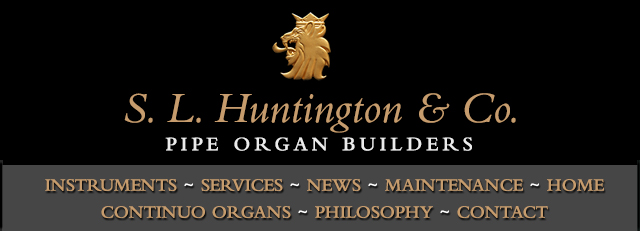
| Great CC-a3 |
| Bourdon |
16' |
(tenor c, wood) |
| Op. Diap. |
8' |
|
| Melodia |
8' |
(wood) |
| Dulciana |
8' |
|
| Octave |
4' |
|
| Twelfth |
3' |
|
| Fifteenth |
2' |
|
| Mixture |
3 Ranks |
(NEW) |
| Swell |
| St'd. Diap. |
8' |
(wood) |
| Viola |
8' |
|
| Harmonic Flute |
4' |
(wood) |
| Violina |
4' |
|
| Contra Fagotto |
16' |
(NEW) |
| Trumpet |
8' |
(NEW) |
| Pedale CC-d1 |
| Bourdon |
16' |
(wood) |
| Flöte |
8' |
(wood) |
|
| Sw. to Gr. |
| Gr. to Ped. |
| Sw. to Ped. |
| Tremolo |
| Bellows Signal |
| Balanced Swell pedal |
| Combination pedals: Forte, Piano |

Before restoration
 |
|
Download a PDF
of Press coverage of an organ concert on this instrument. |
|
 |
St. Andrew’s Church
Episcopal
Valparaiso, Indiana
Hook & Hastings
No. 1417, 1889
Restored and enlarged
2006-07
This splendid catalog-model instrument was originally built for the Baptist Church of West Harwich, Massachusetts (on Cape Cod), in 1889. It remained there without alteration except to the casework and façade, until its removal in the fall of 2005 in anticipation of the sale of the building. The organ is a typical splendid of the well-built and inherently musical instruments built by the renowned Hook firm of Boston, throughout the nineteenth century- a high standard of quality found in every instrument manufactured whether a catalog instrument built to a standardized design with efficient production techniques, or the largest trophy installation. This instrument would have been built at the newly finished Weston factory, with the tonal design by Moritz Baumgarten Jr. who emigrated to this country from Germany where he was associated with the Walcker firm- famous for the large instrument installed in the Boston Music Hall in 1863. Baumgarten’s influence is evident in this instrument particularly in the string voicing which is very reminiscent of German string voicing of the mid-nineteenth century.
Valparaiso, Indiana, once a sleepy university town located in the midst of the northwest Indiana dairy belt, is now a fast growing bedroom community for Chicago. St. Andrew’s, finding they were outgrowing their small historic downtown sanctuary, built a new facility with provision for future expansion, at the north end of the burgeoning metropolis. Father Patrick Ormos who spearheaded the project, was determined that the new edifice would have a pipe organ, and that it should have mechanical action and be a nineteenth-century work of art preserved for future generations. When an anonymous donor agreed to purchase a new instrument but with a time stipulation, a search began for the ideal instrument. The Organ Clearing House was contacted, but did not have an instrument of the desired tonal resources that would fit in the available space- they were either too small, or way too large. It was ultimately determined that the Harwich instrument was the ideal compromise, meticulous restored, but enlarged slightly to incorporate the tonal resources the church desired. The added stops were meticulous recreations of Hook pipework typical of the 1889 period, and were added in such a way that as much of the original mechanism was preserved and as little of the original fabric as possible was altered, and those pieces that were altered, were done so reversibly.
The alterations to the case were reversed, with cutters made to replicate missing pieces of original molding. The beautiful oak casework, hidden under three layers of paint was meticulous stripped and refinished, and the façade pipes were redecorated in the original colors and pattern, using a photo of the organ taken shortly after its original installation as a reference. This may well be the first time in a modern restoration, that milk paint, (the original decorative medium for the facade pipes), was used, yielding spectacularly deep and rich coloration. The gilded pipe mouths are the only portion of the original decoration to still survive, and were preserved intact without change. The balance of the gilding is new, using 22K German gold leaf.
The original handpumping system was restored to operation. The Contra Fagotto 16’, a gift to the congregation from the S.L. Huntington & Co. in the interest of making the instrument as complete as possible, utilizes the original Oboe 8’, now displaced, from middle-c, with a new bass. The original cone tuning has been carefully preserved, and the organ restored as closely as possible to its original condition, both tonally and mechanically. The result is an instrument of amazing color and variety, yet with a dark and noble plenum typical for an instrument of the late-nineteenth century. The individual foundation stops, in particular the flutes, are especially beautiful. The broad, rich, warm tone of the instrument fully engages the acoustically unflattering room. It is hoped in the near future, as finances permit, the suspended ceiling will be replaced with a proper hard surface to maximize the acoustic potential of the dramatic new worship space.
|



